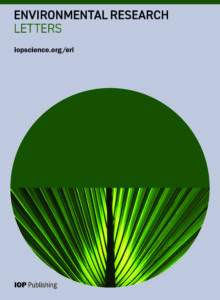ERL特刊征稿|Focus on Carbon Dioxide Removal (CDR)

特刊详情
客座编辑
- Andreas Oschlies,德国基尔亥姆霍兹海洋研究中心
- Julia Pongratz,德国慕尼黑大学
- Sabine Fuss,德国柏林墨卡托全球公共和气候变化研究所
- Matthias Honegger,德国Perspectives Climate Group公司
- Matthias May,德国蒂宾根大学
- Nadine Mengis, 德国基尔亥姆霍兹海洋研究中心
- Christine Merk,德国基尔世界经济研究所
- Gregor Rehder,德国莱布尼茨波罗的海研究所
- Daniela Thrän,德国亥姆霍兹环境研究中心
- Martin Zimmer,德国莱布尼茨热带海洋研究中心
主题范围
- CDR as pathway to mitigate the increasingly drastic consequences of human-made climate change and to achieve the Paris Agreement goals.
- Whether and to what extent CDR methods can play a significant role in the removal and storage of CO2 from the atmosphere, individually and as part of portfolios, and how this potential changes over time (due to climate impacts or due to efforts to scale methods up).
- Considerations on the linkages with and impacts of CDR on the environment, including Earth system feedbacks, economics, society, and governance considerations. We seek contributions both on these individual dimensions and how they impose possible constraints on the feasibility of CDR as well as on the interactions of the dimensions.
- Developing of appropriate approaches for monitoring, attributing, and accounting for carbon storage in a changing environment – the prerequisite for certification and incentivization of CDR.
- Developing and applying assessment frameworks that allow, e.g., political decision-makers to evaluate CDR pathways across all relevant dimensions.
投稿流程
特刊文章与ERL期刊常规文章遵循相同的审稿流程和内容标准,并采用同样的投稿模式。
有关准备文章及投稿的详细信息,可以参阅IOPscience页面的作者指南。
作者可登入期刊主页进行在线投稿,先选择“文章类型”,然后在“选择特刊”的下拉框中选择“Focus on Carbon Dioxide Removal (CDR)”。
投稿截止日期:2024年5月31日。
期刊介绍

- 2022年影响因子:6.7 Citescore: 10.1
- Environmental Research Letters(ERL)以金色开放获取模式出版,作者可选择将原始数据作为补充资料与文章一起发表。所有研究人员可以免费获取这些研究成果。ERL汇聚了关注环境变化及其应对的研究团体和政策制定团体的意见,涵盖了环境科学的所有方面,出版研究快报、综述文章、观点和社论。ERL顺应了环境科学的跨学科发表的趋势,反映了该领域相关的方法、工具和评估战略,得到了来自不同领域的广泛贡献。
